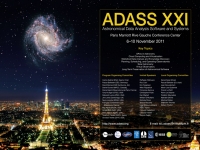Eric Neilsen (Fermi National Accelerator Laboratory)
Abstract
Delivered sky brightness and atmospheric seeing are two important factors in the optimal scheduling of observations in large observing programs, but are less well studied than spherical astronomy. In the Dark Energy Survey (DES), planning software needs to optimize over the requirements of each of its science programs. For example, observing cadence is the primary factor in supernova detection, whereas seeing is the most important factor in weak lensing measurements. Delivered sky brightness is an important factor in filter selection for all programs. We describe models for the short timescale (30 minute) evolution of seeing and delivered sky brightness, and parametrize and test these models using data from CTIO and Apache Point Observatory. Finally, we introduce tools for the prediction of seeing and sky brightness for use in DES exposure scheduling.
Poster in PDF format
Paper ID: P106
Poster Instructions
|

